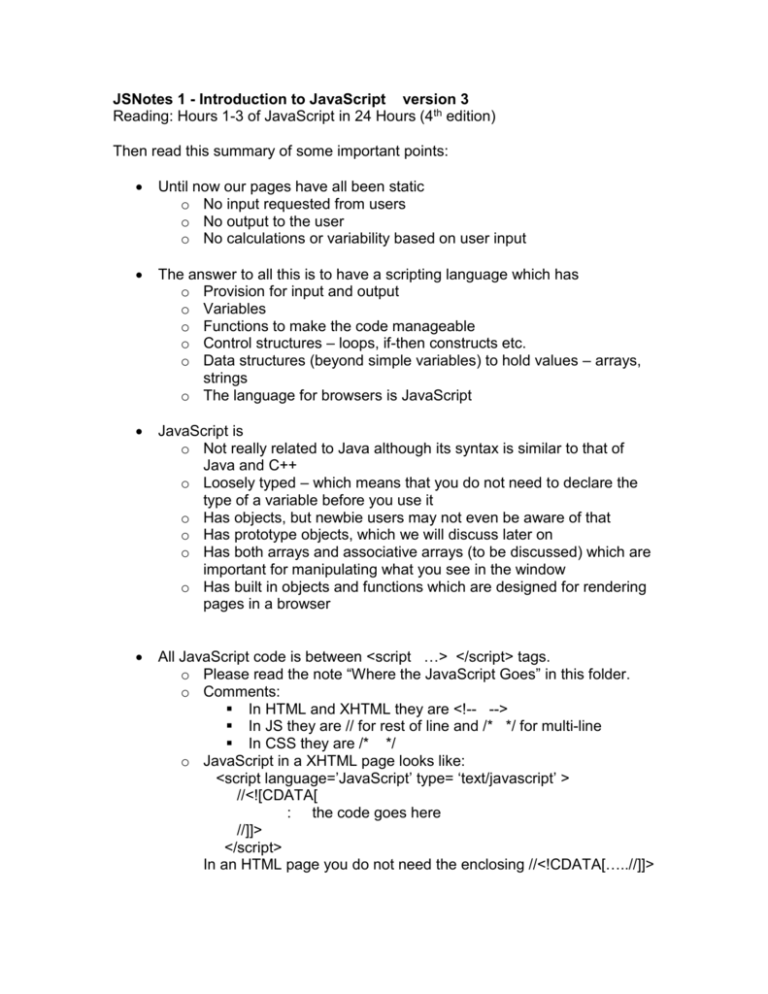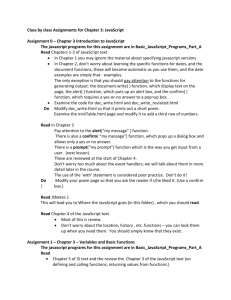JSNotes1 — Introduction to JavaScript
advertisement

JSNotes 1 - Introduction to JavaScript version 3 Reading: Hours 1-3 of JavaScript in 24 Hours (4th edition) Then read this summary of some important points: Until now our pages have all been static o No input requested from users o No output to the user o No calculations or variability based on user input The answer to all this is to have a scripting language which has o Provision for input and output o Variables o Functions to make the code manageable o Control structures – loops, if-then constructs etc. o Data structures (beyond simple variables) to hold values – arrays, strings o The language for browsers is JavaScript JavaScript is o Not really related to Java although its syntax is similar to that of Java and C++ o Loosely typed – which means that you do not need to declare the type of a variable before you use it o Has objects, but newbie users may not even be aware of that o Has prototype objects, which we will discuss later on o Has both arrays and associative arrays (to be discussed) which are important for manipulating what you see in the window o Has built in objects and functions which are designed for rendering pages in a browser All JavaScript code is between <script …> </script> tags. o Please read the note “Where the JavaScript Goes” in this folder. o Comments: In HTML and XHTML they are <!-- --> In JS they are // for rest of line and /* */ for multi-line In CSS they are /* */ o JavaScript in a XHTML page looks like: <script language=’JavaScript’ type= ‘text/javascript’ > //<![CDATA[ : the code goes here //]]> </script> In an HTML page you do not need the enclosing //<!CDATA[…..//]]> o JavaScript in a separate file is linked to by: <script language=’JavaScript’ type= ‘text/javascript’ src=’’myCode.js’ > </script> The code itself goes into a file myCode.js without the script tags. Unlike XTHML, javascript is case sensitive – for reserved words, variable and function names, etc. The easiest output is alert(‘message to print’) The easiest input is myVar=prompt(‘message to prompt user’) Any input from the prompt function is a string – so you need to turn it into an integer or floating point number with the parseInt() or parseFloat() function: name = prompt(‘What is your name?’) age = parseInt(prompt(‘How old are you?)) Other output (than alert and confirm messages) is through the document.write function: document.write(‘Hi there ‘) document.write(name) That is, the parameter to a document.write function is either a variable (such as name) or a string (enclosed in single or double quotes.) These may be combined through string concatenation – for which the operator is + document.write(“Hi there “+name+”!”) Semi-colons at the end of a line of code are optional –but semi-colons should always be included except when you have statements enclosed in braces because in certain complex coding the semi-colons prevent parsing errors. Semi-colons may also be used to separate statements when more than one statement is on the same line. Functions are defined in the head, beginning with the word function: function myFunc(parameter list) and are called in the body with: myFunc(2,7,name)








